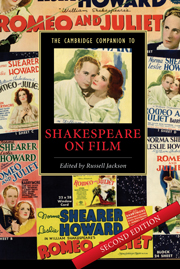Book contents
- Frontmatter
- Introduction: Shakespeare, films and the marketplace
- Part I Adaptation and its Contexts
- 1 From play-script to screenplay
- 2 Video and its paradoxes
- 3 Critical junctures in Shakespeare screen history: the case of Richard III
- 4 Shakespeare and movie genre: the case of Hamlet
- Part II Genres and Plays
- Part III Directors
- Part IV Critical Issues
- Further Reading
- Filmography
- Index
- Series List
1 - From play-script to screenplay
from Part I - Adaptation and its Contexts
Published online by Cambridge University Press: 28 July 2007
- Frontmatter
- Introduction: Shakespeare, films and the marketplace
- Part I Adaptation and its Contexts
- 1 From play-script to screenplay
- 2 Video and its paradoxes
- 3 Critical junctures in Shakespeare screen history: the case of Richard III
- 4 Shakespeare and movie genre: the case of Hamlet
- Part II Genres and Plays
- Part III Directors
- Part IV Critical Issues
- Further Reading
- Filmography
- Index
- Series List
Summary
In fashioning their theatrical raw material into screenplays the makers of Shakespearean films have adopted strategies as diverse as the impulses behind their various projects. The wish to convey faithfully some of the perceived qualities of the chosen play has led to the adoption or rejection in varying degrees of the original’s dramatic structure, language and character relationships. The Introduction to this Companion has already suggested some ways in which commercial considerations might not only influence the way a Shakespeare film is promoted, but stipulate outlines to which characterisation and narrative may conform. The example, for better or worse, of what has already been sold successfully is reflected in the affinities with film genre that Harry Keyishian discusses below (chapter 4). As Geoffrey O'Brien observed in February 1997 - when another flurry of new Shakespeare films had just been released - 'singular opportunities have been created, not to recapitulate, but to invent'. In the study of film techniques a broad distinction can be made between films in which story-telling is effected by the montage of images, and which foreground the means by which this is done; and others which conceal the art which places dramatic scenes before the camera with an illusion of unobstructed and privileged access for the audience. Identified in particular with Hollywood before the 1960s, this latter style of 'continuity editing' came to be accepted as a norm of mainstream cinema.
- Type
- Chapter
- Information
- The Cambridge Companion to Shakespeare on Film , pp. 15 - 34Publisher: Cambridge University PressPrint publication year: 2007
- 1
- Cited by

